It was bound to happen; Yamaha came out with their Spark equivalent. I must say, there are quite a few things that they did that Sea-Doo could learn from, and a few others that Sea-Doo leads the way.
I want to go over some of the key improvements and features that are worth mentioning for this new watercraft. I know I’ve been quite biased towards Sea-Doo, but I think the Yamaha EX has some features that need to be pointed out.
One big reason you should read this is that I’m not being sponsored by Yamaha or Sea-Doo. Everything I say is my words and money is not being exchanged to say it. I have a strong background in the watercraft-world, and I want to share my opinion.
The History
The reason why the Spark and EX exist needs to be explained.
When the Sea-Doo Spark was first released in 2014, it took the world by storm. There was nothing like it, and a PWC priced a $4,999 was groundbreaking. Before then, a PWC priced under $8,000 was a good deal, with the other models going above $15,000.
And then to have them in 5 color options with seating configurations too, nothing else like it had been done.
We could not keep these things in stock, especially when they had features like iBR that the bigger models had. The Sparks open jet skis to many people who would have never gotten them, they could even tow them with their cars. Even when gas prices got high, the Spark had the best MPG of anything on the water. Sea-Doo simply hit it out of the park with the Spark.
Yamaha was watching, and I don’t think they expected Sea-Doo to do something so bold. Yamaha, for years, was the cheaper option, but with the Spark being almost half of their cheapest models, they went to work making their own.
In 2017, Yamaha made its version called the EX.
It was a smaller model, and the price point was much lower, but it still was not the same as the Spark that I go over in this post. Yamaha could not do a fully Polytec hull like the Spark, and that is what kept the price and weight higher.
What both the Spark and EX have done is made it clear that there are people who want simple, nimble, and easy watercraft. Ever since the release of 4-stroke jet skis, they have been getting bigger and more costly every year. People were getting priced out and scared away, but the release of the Spark changed all that.
The Tricks!
Before we go too deep into the review, I want to show a video that shows off that the Spark and EX are more than for cruising.
The Spark and EX have been finding their grove with the Trixx and JetBlaster models. These watercraft are more playful, and it’s what people been really wanting all along.
The video below is a great example of having fun on such watercraft.
The regular Spark and EX are more tamed, they can get close to these tricks, but you need to get the Trixx or JetBlaster to do them fully. Don’t be put off from seeing these things, they’re quite stable for what they are and will be a great option for a watercraft if you just want to ride.
No 2 Seater On The EX
One of the first things I’ve noticed about the EX is that they only have a 3 seater option, this was probably too costly to make two different hulls.
I would like to point out that in this Rec-Lite category, a 3 seater is really a 2 seater and a 2 seater is really a 1 seater. Maybe two adults and one child on a 3 seater, but 3 grown men are not going to fit on a 3 seater in the REC-LITE category – let’s be real.
Not going after this 2 seater category, Yamaha will miss out on the cheaper models and thus lose a good portion of customers.
Below is an example of the Spark 2 and 3 person seats. As you can see, the space is tight.
The picture above shows the difference between the 2 UP and 3 UP Spark, not only for the seats, but the rear of the 3 UP having the extension platform.
Different Body
I’m quite surprised that Yamaha didn’t go after the Polytec body as Sea-Doo did. It could be due to patent issues, but I figured Yamaha would have a workaround to this matter. Yamaha uses fiberglass hull instead, just like their other models.
Yamaha does have a plastic-style seat support, which does help cut down on weight, but the waverunner is not entirely plastic. This could be a reason why they didn’t go with a 2 seater, as it would be too expensive to make with a fiberglass body?
Having the fiberglass body will help soothe the people who never liked the plastic Polytec bodies. Both fiberglass and Polytec have their advantages and disadvantages, so really all you got to do is pick your poison on this one.
Spark Vs. EX Weight
The weight on the Sparks Vs EX is quite a bit different.
The EX went with the heavier fiberglass and weighs in at 577 pounds. The Spark uses Polytec, and it weighs in at 421 pounds. That is 156 pounds lighter for the Spark, which matters a lot when it comes to weight capacity of jet skis.
The weight of a jet ski affects performance, MPG, and how much gear you can carry. How much you can carry differs for the models that I’ll also cover later.
Engine Horsepower
Yamaha is using the TR-1 engine in the EX series, but it is a bit different.
They have made some modifications to make it lighter, and it only produces 100HP. That is 10 more horsepower (about a lawnmower more HP) than the Spark at 90HP.
One could argue the 10HP more is needed since the craft is 156 pounds heavier.
Both the 90HP Spark and the 100HP EX do about 50 mph, but the EX will edge out the Spark in a drag race. Either way, both are going fast enough for the average or beginner rider.
Sea-Doo does have a 60HP option that is only in a 2 seater base model, which does 42 mph. It’s cheaper and gets you on the water.
Sport Mode
The 90HP Spark has different driving modes, default and sport mode.
Both modes will get you to top speed, but sport mode has a quicker take-off.
If you have a VTS (trim) on your Spark, you can also adjust it all the way up to do wheelies. The wheelies are easier on the Trixx as it has an extended VTS.
Fuel Economy
Compared to the larger models that each manufacturer sells, both the EX and Spark are very good on gas.
The 90HP Sea-Doo Spark gets about 2.5 GPH at cruising, and the EX gets about 3.2 GPH. The 60HP Spark gets about 2 GPH.
GPH is gallons per hour, similar to MPG, but a more accurate measurement for boats.
Fuel Tank
This is where I must say Yamaha did a good job at.
The EX has a big 13.2 gallon gas tank, while the Spark is only at 7.9 gallons.
Bot jet skis are not long-distance machines, but since we know the GPH, we can figure out how long you can ride each one.
The Spark uses 2.5 gallons per hour and has a 7.9 gallon gas tank, so it can go for about 3.16 hours.
The EX uses 3.2 gallons per hour and has a 13.2 gallon gas tank, so it can go for about 4.12 hours.
When it comes in-between fill ups, the EX wins this one. Keep in mind, your gas mileage may be different, better or worse, as people adjust the throttle often and have different riding conditions.
The Seating
The biggest problem with any REC-LITE jet ski is that the seats on them just suck.
You may not understand it when you sit on one at the dealership, but ride one for about 45 minutes and your butt will start to hurt.
This is where Yamaha didn’t get it right. Yamaha did what Sea-Doo did and made small and thin seats with no extra foam padding. I get why they did it, to save on costs, but it’d be good to have a touring seat available with these watercraft.
I’m sure when buying an EX or Spark the last thing through people’s minds is the seat, but trust me, I’ve owned and ridden many styles of watercraft, and the seat is the most crucial part of it.
Mirrors
When you step up to the EX Sport and above, you get dual mirrors. You can now buy mirrors for your Spark (Amazon Link Ad).
Mirrors on a jet ski are important, it’s one of the things you learn about when taking a boating test, and many states require them by law.
Storage Capacity
If you’re looking at the REC-LITE series of watercraft, then storage capacity should NOT be a concern for you, as they don’t have much.
Everything you possibly need can be stored in a dry bag (Amazon Link Ad) and latched or hooked to the watercraft somehow. Also, a dry bag is needed, as the storage on a REC-LITE is NOT dry.
EX has about 10 gallons of storage, which is quite a lot compared to the Spark with Convenience Package at 7.42 gallons.
While the EX has more storage, it’s scattered in multiple places. The Spark gives you one big bucket when you have the front storage like I have in the picture below.
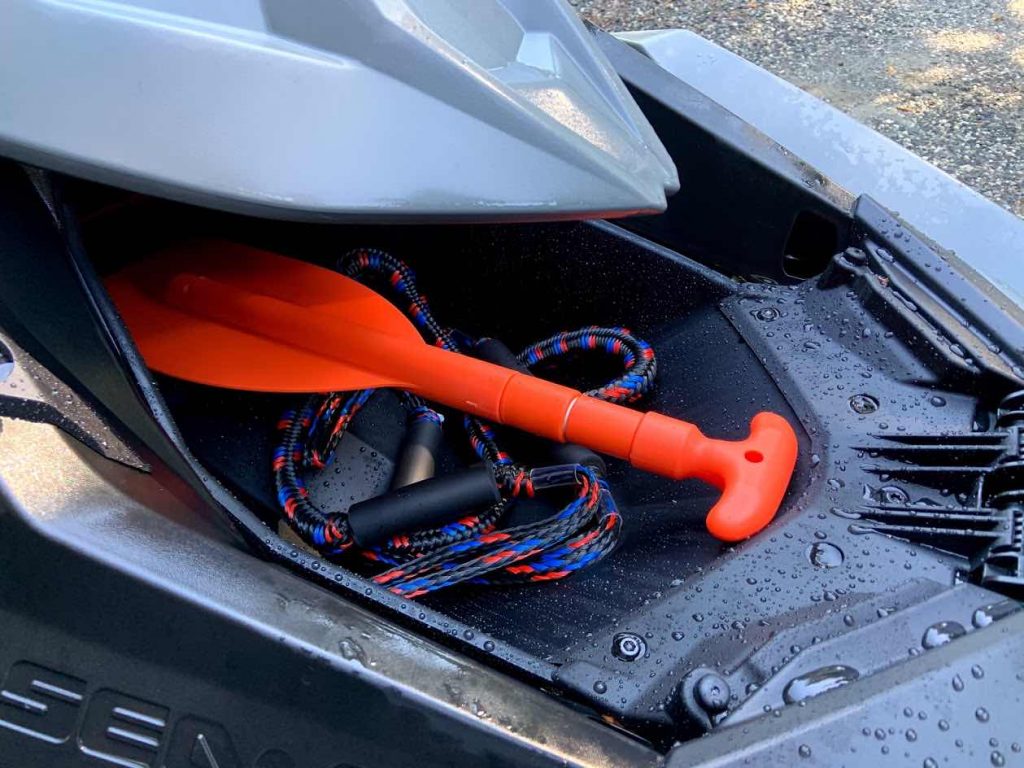
You could not fit a folding paddle or even a life jacket into an EX, as the video below shows.
Yamaha now has an option to expand the front storage with a dry bag, but the Sea-Doo is slightly better if you ask me.
Engine Access
One good thing is that Yamaha EX has better access to the engine than the Spark does.
Sure, you can get to all the important stuff on your Spark through the access panel on the side, but the EX has the top access.
The Spark access panel pictured above can have you get to the battery, fuses, coolant, starter relay, and a few more things.
If you’re going to do anything more, you need to take the whole top deck off, while it sucks, once done it’s the easiest watercraft to work on.
Trixx Vs. JetBlaster
Both Sea-Doo and Yamaha have more playful models that do more “tricks”.
It’s a kick back to the 90s, when jet skis were fun and not fast.
I have a whole post covering the Sea-Doo Trixx vs Yamaha JetBlaster.
Color Options
When the Spark first came out you had 5 color options and over time they slowly removed more and more options.
Instead, Sea-Doo started to mix colors and with the world shutting down and supply chain issues, we see the fewest color options.
You can get decals for your Spark to help it stand out more, but it seems Sea-Doo is going away from too many options. It did create many confusions, as customers thought they could just build the one they wanted, but the dealers only got so many options themselves.
The EX doesn’t do a lot of colors themselves, but Yamaha is less likely to do funky colors or stand out colors like Sea-Doo.
Size
The Spark and the EX are about the same size.
The 3up Spark is 120 inches long and the EX is 123 inches long.
The 3up Spark is 46 inches wide, and the EX is 46 inches wide.
Both watercraft will be about the same as being stable in the water. I feel like the EX will look bigger in person, but both are about the same size.
The Spark will be about 156 pounds lighter, something to consider when pulling with a small car. To see the full list of jet ski weight, go here.
Overall
Really, whichever model you pick, you’re going to like it. I have never seen anyone buy a jet ski and not like it.
Yamaha has really brought in a good competitor to the Sparks; there are some great features that Sea-Doo could learn from. I really think the Base EX is a good machine and competes very well.
Whatever watercraft you do get, you got to make sure you get the correct accessories with it!
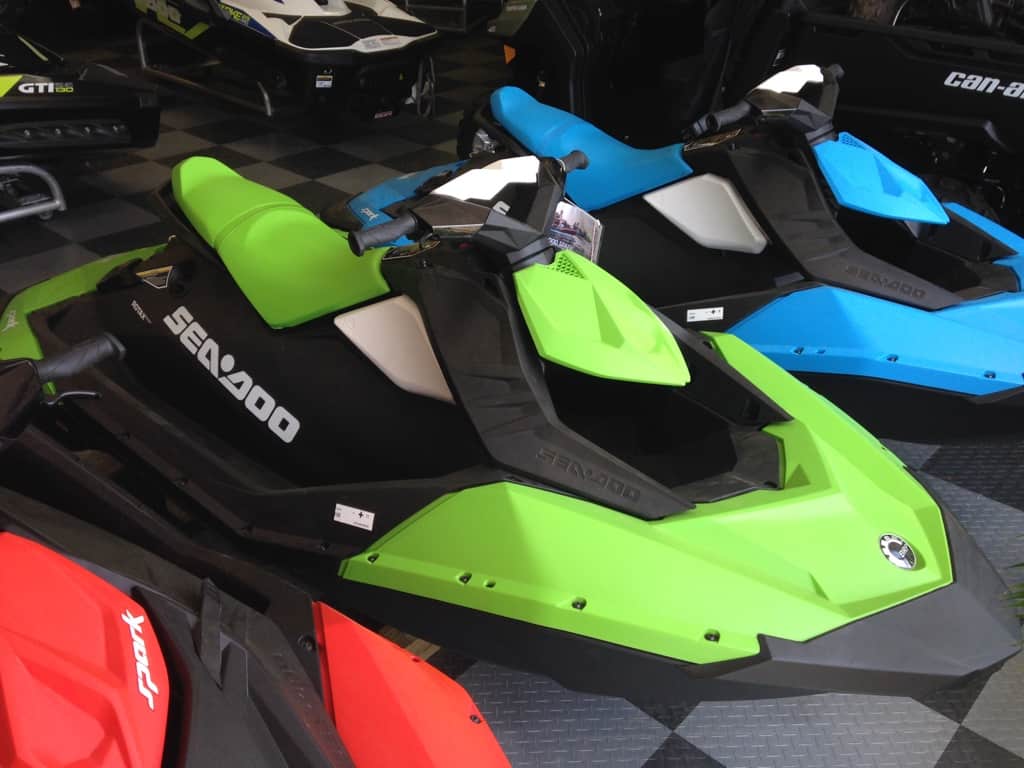
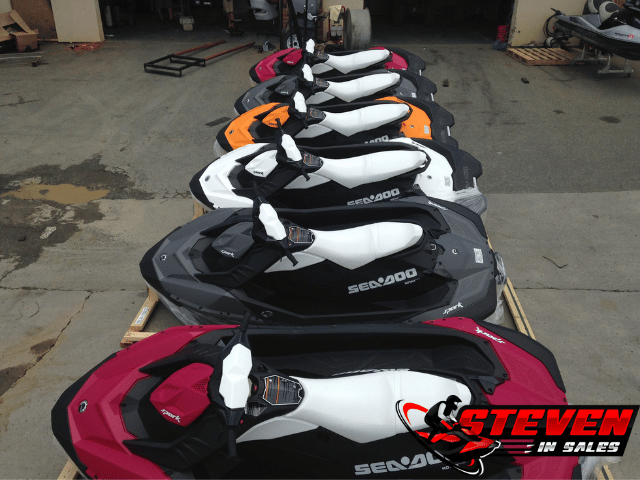
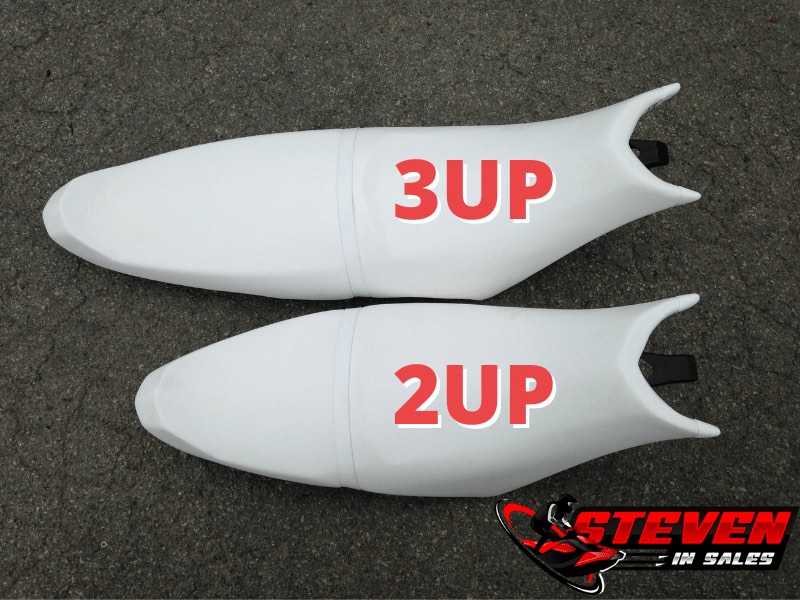
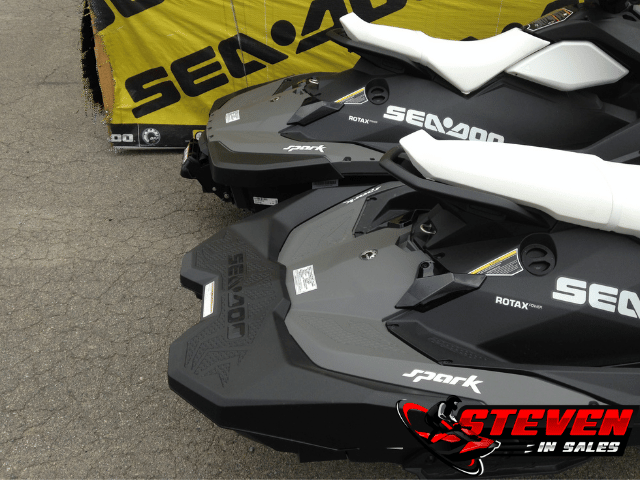
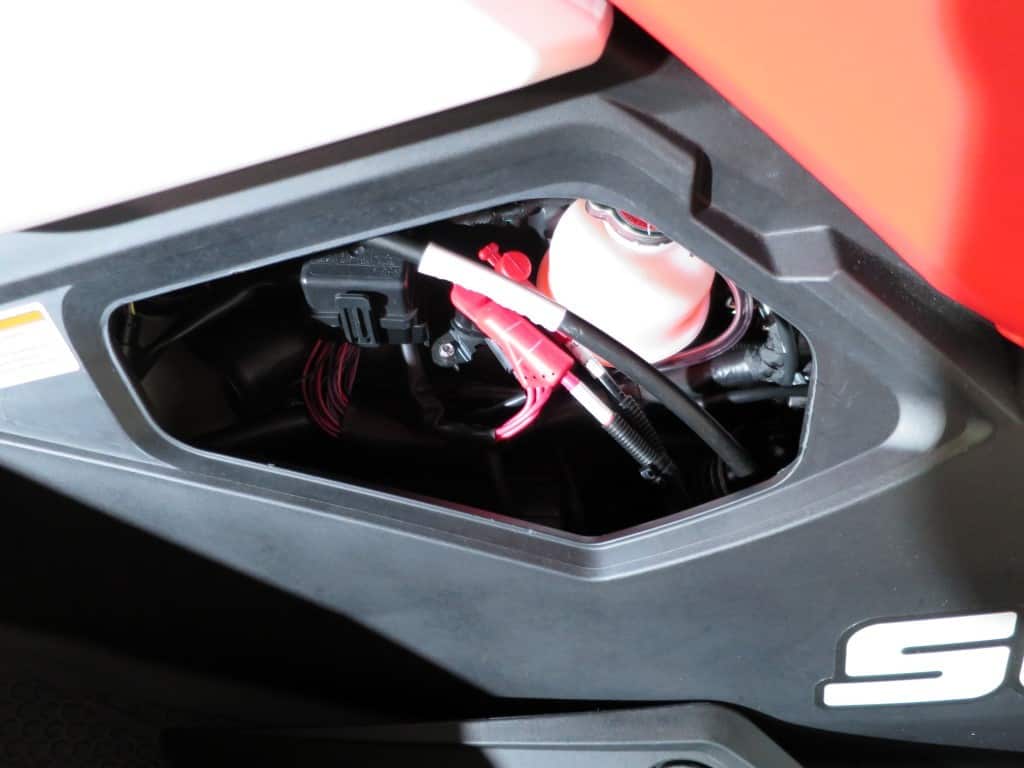
I was on the fence for about a month between the Sport and the Spark. They are the exact same price right not,Spring of 2018 for a 2017 model. A few things. The wear ring.I know you said you had your original one but a simple search on google of Yamaha Wear Ring Problems and Spark Wear Ring problems will yield hundreds .of Spark owners with wear ring issues. I seems to be a flaw, not covered under warranty, and if you relalce it yourself, warranty voided, if you use a non Sea Doo stainless wear ring, warranty voided. Since Sea Doo makes their own stainless wear ring, they know the Spark needs one. Next is teh prop. The Sea Doo prop ias aluminum, and the EX is stainless. flex vs rigidness…. the aluminum prop is a cheap, inexpensive disposable prop. Again, you need to get a genuine Sea Doo one and have it dealer installed to keep the warranty. There is a cooling system debate, with the EX not getting up to proper temp and also sucking in debris through it’s cooling system vs the Spark closed loop system, byt there are several recalls for the Spark system already. For $7K i was able to find a 2017 Spark 3 UP 90- ACE IBR with 3 year warranty if purchased prior to May 1, The 2 deal breakers were when I had a 800XP, it was a money pit. Constant issues, RAVE pod problems, etc. The second was the Waverunner series seems to be the choice of rentals, proving it reliability amd strength. I was reelly sold on the Spark, and the color scheme is edgy and “sweet” where the EX is like a baked plain baked potato with nothing on it, but I went with the EX. I will pick it up in several weeks, and we wills ee if I made the correct choice.
Congrats on getting a Ski!
I do want to make note that if you suck up anything into any watercraft it’s not covered under warranty. It would be like running something over in your car and expecting the manufacturer to cover the damage to your car. I highly recommend everyone to not start any watercraft in less than 3 feet of water to avoid sucking things up. These things are very powerful vacuums and will suck up rocks, sticks, and anything in its way. And I’ve never heard of changing your wear ring voiding your warranty, that could be bad dealerships so watch out for that no matter if its a Sea-Doo or Yamaha.
Yamaha makes a quality product. I had a 97 Waveblaster II that was indestructible. I left a lot of others at the dock. It never failed me and i rode it a lot. I have seen many skis broke down and the Yamahas just last. The Polaris (Tigershark) was the worst, followed by Sea Doo, Kawasaki, and finally Yamaha. No matter what features you have, the ski is worthless if it has to go to the shop every time you get ready to ride it.
Hi Steven,
We bought a pair of EX Sports a few months back. My main complaint is stability. These skis are truly one person skis. I won’t allow more then one to go out on them. Reading through the blog I too agree that the seats and storage are an issue but I knew this prior to purchase. I have to say though they are a fun ride and fast. They like to get airborne when hitting a wake and when you beach them there light enough to push off. I owed a couple of Sea Doos prior to this purchase and had nothing but problems with them.
Hi we are looking to buy our first JetSki for the family and are torn between the Yamaha ex dulux and the sea doo gti 90 any advice would be greatly appreciated.
Thanks Naomi
I would personally go with the GTI 90 over the EX. The GTI would be more stable, go for longer on a tank of gas, better suited for pull sports(more stable), and has a lot more storage. Plus, the seat on the GTI 90 is so much bigger and a ton more comfortable. Here is a review I did on the GTI 90 here…https://www.steveninsales.com/best-watercraft-2017-gti-90/
Thanks very much Steven!!
Hi Steven,
Wow!!! Thank you very much for the very detailed response. I was worried my post was too long, but based on your response it looks like I’m OK. 😉
On a more serious note. I can’t believe that someone I don’t know took the time to write such a detailed and insightful response. I checked out the videos on both of your links. The second link referencing how to drive a Sea-Doo was very helpful.
Thank you very much for your time and for sharing your knowledge.
Thanks,
Mike
It’s no problem. Feel free to explore this site some more, I have a ton of information on Jet Ski’s and all the common questions people have asked me over the years about them.
I’m looking at my first pwc purchase. The spark starting at $5299 is what got me thinking about the purchase, but by the time I got the options that I wanted to have on the Spark, (the spark price included the optional depth finder) the price was close to that of the GTI 90 without additional options and the Yamaha EX Deluxe.
In comparing the Sea Doo ibr against the Yamaha Ride technology, I’m favoring Yamaha because of what I’ve read, although I haven’t ridden either model. Here’s what I’ve read:
A. The Yamaha reverse pushes water out each side of the bucket instead of pushing down (and possibly stirring up debris).
B. In the videos I’ve seen, when coming to a quick stop, the Sea Doo ibr seems to push the bow down into the water a little more than I would like. The Yamaha quick stop seems to keep the ski more level. I’m not worried if it takes me a little bit longer to stop.
I did see a Sea Doo Video talking about a second generation of the Sea doo ibr, but I couldn’t tell what year the second generation was introduced, or if it helped the issue of the bow push down when coming to a quick stop.
A few Questions:
1. Do you have any additional information on the second generation ibr?
2. Does the Yamaha Ride technology start the machine in neutral as the Sea Doo ibr does?
3. Is the reverse simply an on/off for these technologies, or is it variable? What I’m really looking to find out is how intense the shift to reverse will be when docking the ski. Obviously, gentle touches are the best way to go assuming there isn’t a strong wind.
Either the Spark or an EX would make a good first ski, but you’ll soon want to upgrade and the GTI 90 would be a way better machine. I even consider it to be the best watercraft of 2017 in this post here. Both the iBR and Ride work differently but ultimately do the same thing. The reason why Yamaha does it differently then Sea-Doo is due to Sea-Doo having the patents on the tech and Ride is just a work around those patents so that Yamaha is not left behind. Sea-Doo is on the next generation of watercraft braking and has fixed the issues you mentioned. Sea-Doo has had the iBR since 2009 and in 2016 and even 2017 it feels perfected and more fine tuned compared to Ride which came out in 2015. On all 2016 and up Sea-Doo and all Sparks when you hit the brakes the craft stays stable and does not take a nose dive. The Sea-Doo’s with the old iBR didn’t nose dive until the very end of the stop, so for 95% of holding the brake you stayed level but the last 5% it did nose dive but now on all 2016 models it doesn’t nose dive at all. All Sea-Doo push the water to the side when you hold the reverse lever in, they have to if you want to steer in reverse. The Sea-Doo iBR is a 2-level system. The first level is the brake where the bucket drops a little bit to slow you down. When You’re stopped and slowed down enough the iBR goes to the second level of the bucket where the flaps on the side allow you to steer and not worry about kicking up sand and such. The only boat I know of that kicks the propulsion down when you go in reverse is Yamaha’s Sportboats, all the smaller watercraft I’ve see kick it to the side when in reverse.
To answer your questions:
1. Second generation iBR came out in 2016, it’s pretty much the same design the Spark has had since 2014 and is superior. I have more info in detail about 2016 Sea-Doo vs Yamaha here. Most of what is covered in 2016 is much the same as 2017.
2.Both Ride and iBR start in neutral. The interesting part about neutral on any water doesn’t matter if Yamaha or Sea-Doo is that “neutral” is not really neutral. Neutral on a watercraft is just the spot between forward and reverse. So if the engine is on the impeller is spinning. They do this to keep it simple and not have a transmission on a watercraft(fewer moving parts the better). Most people may never even realize that it’s not true neutral because of how perfected both are, but I know with the Sea-Doo you can actually fine tune the neutral anyway you want it. I know some people who like having a very very very slow creep forward for their natural that helps them put it on the trailer easier.
3.The brakes on both are variable, the more you squeeze the more you stop. What is different is how Yamaha handles reverse compared to Sea-Doo. The more you squeeze the left trigger on the Yamaha the more the bucket drops and the more the engine rev’s up. It’s easy to overdo it on a Yamaha with Ride going into reverse and overcorrect and hit the dock. But the Sea-Doo on the other hand when you squeeze the left trigger it only drops the reverse bucket and that’s it. If you want to give it gas in reverse you can by reviving the right trigger while holding the left trigger in. For anyone new, I don’t recommend revving the engine at all when near the docks or trailers to avoid overcorrecting and hitting something with too much force. You should be going slow in a no-wake area anyways and revving the engine creates unneeded waves. iBR also keeps you from overdoing it especially when first hopping on the craft to start it at the docks or getting it off the trailer. You’ll be amazed by how many people I see on a Yamaha with Ride gunning it in reverse off their trailer and being stuck because they didn’t back up enough in the water and when they get free they got full power in reverse and they panic and hit something. I created a YouTube Video Here about how to drive a Sea-Doo that you can see real world use of the reverse, keep in mind that the ski in the video has the first generation iBR but fundamentally works the same as the second generation.
What about the stainless wear ring in the Yamaha and the vinyl in the spark. I heard one gulf of sand and the spark is in for a wear ring replacement. True?
The Spark has a Plastic Wear ring like the other Sea-Doo models. The Spark wear ring is thinner than the normal Sea-Doo one but still very strong. I still have my original wear ring in my 2014 Spark and it’s fine. Sucking up sand or other light debris won’t damage it but sucking up big stuff like rocks will. The same goes for Yamaha with their metal housing, a rock can destroy it too and sand won’t affect it. What is different is the cost to repair, metal wear rings will cost more than the plastic one. If you must have a metal wear ring for the Spark then Sea-Doo does sell a metal one but I don’t see the need for it. 99% of the time when the wear ring gets damaged it’s a user error so it won’t matter if you ride Yamaha or Sea-Doo if you don’t keep in mind that you’re driving a very powerful vacuum.
Yeah but the 2017 ex deluxe comes with a 4 year warranty while the gti 90 has a 6 month warranty and no boarding ladder the warranty is crazy to me
Every place is going to have different warranties, but the standard in the industry is to give a 1-year warranty on all machines unless you live in a special state. It’s looking like the GTI 90 was a good seller in 2017 so there is not many on the market while the EX Deluxe did not sell well and many dealers still have a bunch so Yamaha is forced to come out with attractive promotions to help sell them. Local to me the promotions right now for a 2018 GTI 90 is a 3-year warranty or $500 off, this, of course, is different and will change soon but I would rather go with a 2018 model with a bigger hull than last years model with a smaller hull.